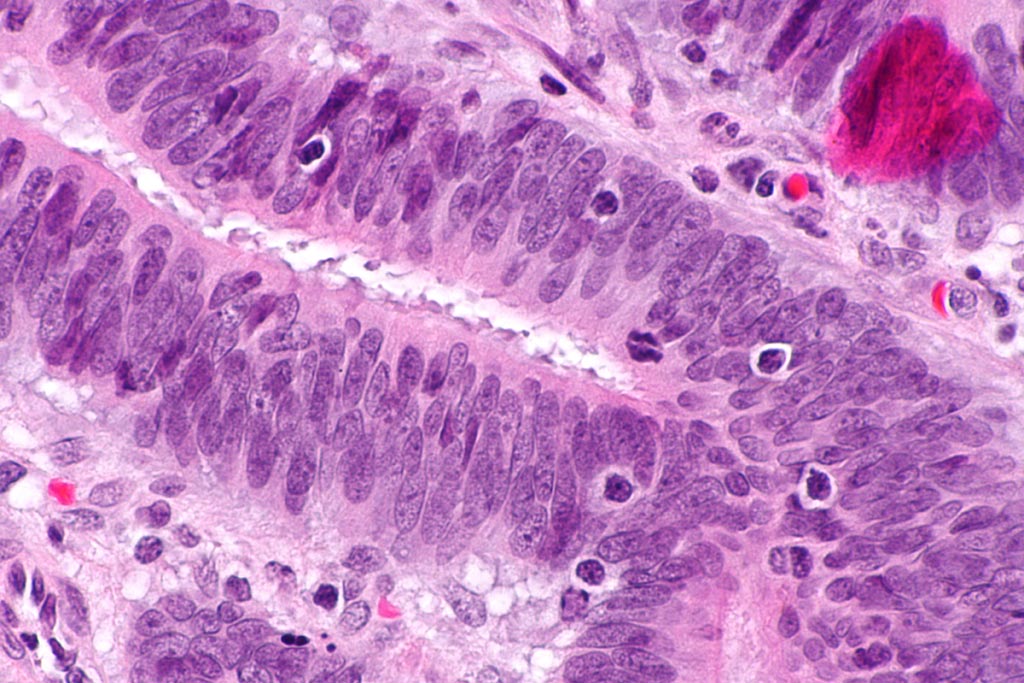Tumor Microenvironment May Provide Biomarker for Women with TNBC
By LabMedica International staff writers
Posted on 10 Oct 2017
Researchers found that the presence of tumor-infiltrating lymphocytes (TILs) varied significantly in the tumors of African-American and European-American women with triple negative breast cancer (TNBC), suggesting that TILs counts may help determine prognosis.Posted on 10 Oct 2017
TNBC is a highly aggressive breast cancer subtype that afflicts African-American women at a higher rate than white women, and often involves a worse prognosis, said study lead author Nikita Wright, a PhD student at Georgia State University (Atlanta, GA, USA). TNBC does not express 3 of the proteins that cause other types of breast tumors to grow – estrogen receptor, progesterone receptor, or Her2/neu. Therefore, there are no targeted therapies currently available for TNBC.

Image: Micrograph showing tumor-infiltrating lymphocytes in colorectal carcinoma. H&E stain. Tumor-infiltrating lymphocytes (TILs) are suggestive of microsatellite instability (MSI) (Photo courtesy of Wikimedia).
Previous research has shown that African-American women tend to develop more aggressive subtypes of TNBC than European-American women, exacerbating the disparity in survival. “Thus, there is an urgent need to investigate robust, clinically applicable biomarkers that can help clinicians discern which patients are likely to have a more aggressive disease course and guide the personalized treatment of TNBC,” said Wright.
Previous research has also shown that higher counts of TILs are associated with better survival in TNBC patients. Further research would be required to explain the mechanisms, but one theory is that more aggressive tumors elicit stronger infiltration of lymphocytes into the tumor.
Wright and colleagues tested resection samples from 142 TNBC patients at Emory Hospital (Atlanta, GA, USA), and compared overall (stromal) TILs between patients of African-American and European-American descent. None of the patients had undergone neoadjuvant chemotherapy. The results showed that African-American patients harbored significantly more overall TILs than European-American patients. Significant differences were also observed among early-stage TNBC patients, but not among late-stage patients.
High peripheral TILs were associated with better 10-year survival among early stage African-American TNBC patients, after adjusting for age, Nottingham grade, and stage. A greater presence of overall and peripheral TILs were also associated with a lack of androgen receptor (AR) expression among early-stage African-American TNBC patients. The lack of AR reception classifies some TNBC cases as quadruple negative, and this subtype is more prevalent among African-American compared to European-American TNBC patients.
Among African-American patients with early-stage TNBC, high TIL counts were also associated with younger age at diagnosis, increased intramammary lymph node involvement, increased BRCA1-associated protein expression, and programmed cell death protein 1 expression.
Considering the range of characteristics that were associated with higher TIL counts, testing for TILs could potentially provide clinicians with useful information for prognosis. “These findings uncover a previously unrecognized disparity in the tumor microenvironment between African-American and European-American TNBC patients,” Wright said, “If confirmed, these findings suggest TILs can be used to predict patient prognosis in the early stages of disease for African American TNBC patients. This insight is clinically actionable and of great potential value for guiding treatment of these patients so that their survival may be improved.”
Wright said the study’s main limitation is that it only included patients who did not receive neoadjuvant chemotherapy. Retrospective studies that examine racial disparities in TILs among patients who did receive neoadjuvant chemotherapy could help confirm the role of TILs in TNBC.
The study was presented at the 10th AACR (American Association for Cancer Research) Conference on The Science of Cancer Health Disparities in Racial/Ethnic Minorities and the Medically Underserved (Atlanta, GA, USA, September 25-28, 2017).
Related Links:
Georgia State University














